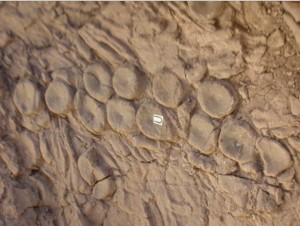In New Zealand, most of the news today centres around the Rena environmental disaster currently unfolding off our coastline.

So I thought I’d bring in something else nautically-related, but this more on the subject of beasties historically thought to put holes in ships, than ships with holes themselves.
Sort of.
Some of you may be familiar with the Kraken, a mythological squid/octopus-like creature apparently resting at the bottom of the ocean, and which is able to eat ships as one might eat one’s morning cereal bits. Or something. It’s a subject I’ve a little interest in, given my love of cephalopods :)
Well, exciting stuff! Research which has eagerly been attached to, with lots and lots of newsy suckers*, suggests that our ancient oceans contained 30m long giant, superintelligent squids which liked to play with their food: in this case, icthyosaurs.
Since its discovery, paleontologists have been somewhat confused by the remains found in some 215 million year old (or so), Late Triassic rocks. The rocks, located in Central Nevada in the Berlin-Ichthyosaur State Park, contain the remains of lots of large Icthyosaurs called Shonisaurus popularis. What has been causing the perplexion, however, is the arrangement of these fossils.
Firstly, it’s a mass death site, which is of interest. Hypotheses abound as to why this might be, but no actual definitive answers.
Secondly, and even better, some of the fossils don’t appear to be randomly arranged. There are _patterns_. For example, a double row of vertebrae which look like they were fit together by size.
Certainly it raises some eyebrows, but now, two scientists have posited an interesting hypothesis of their own: an enormous, very intelligent squid did it. They killed the icthyosaurs and arranged their bones into middens. The double row of vertebrae could even have been a self-portrait, as it resembles the arrangement of suckers on a tentacle. The squid would, they say, have been about 100ft (30m) long.
So there’s the background.
I’ll admit, much as I love the idea, there’s the issue of Occam’s razor. The site shows no evidence whatsoever of squid remains. One wonders whether other forces - like sediment moving due to currents/tectonic activity, currents themselves, scavenger activity - might have helped in the fossils’ arrangement.
Blogger Laelaps has written a wonderful piece on the subject. Highly recommended reading.
My problem here, other than wanting to start making happy ‘giant squid squeee!’ sounds or giggle so much I fall off my chair, is a serious one.
Firstly, it doesn’t appear that many of the stories about it got second opinions (although the LA times has got some of the pithier quips here). This is Not Good, particularly when covering areas such as science!
Secondly, it reeks a little of courting media attention without much attendant dignity. Which doesn’t look great from the outside, and tends to come at some point with a public backlash from people who think science is about grandstanding rather than getting to the facts.
Even worse, when news-making science then turns out to be heavily inaccurate, it’s pounced on by the anti-science bridage as proof-positive that scientists are, essentially, liars. Which really, _really_ doesn’t help with issues such as climate change.
So yes - next time you see an extravagant science claim? Check the paper (research paper)**. Check the sources. And journalists? Ask someone else, too.
——-
Related posts
——-
* Nature News has it. As does LiveScience, CBS News, FOX (O_o), the Huffington Post, Pop Sci (I’m saddened) and a number of other news sites.
** If the research isn’t even _from_ a published, peer-reviewed paper? Be extra careful.